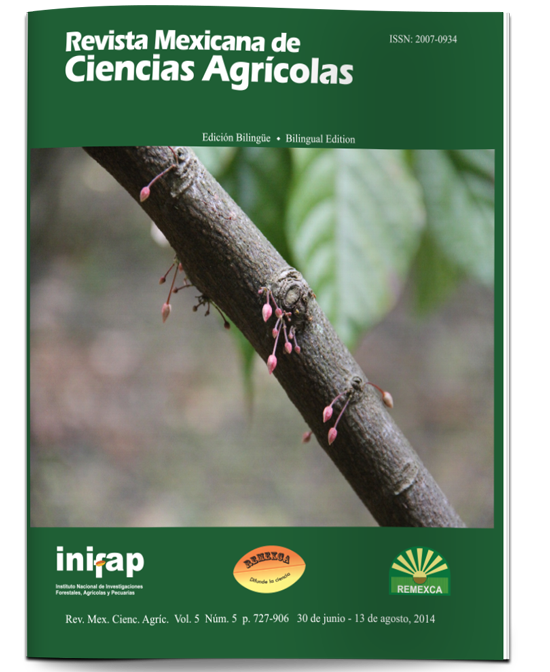Fertility and feeding of Tamarixia triozae (Hymenoptera: Eulophidae) on potato psyllid Bactericera cockerelli
DOI:
https://doi.org/10.29312/remexca.v5i5.912Keywords:
Tamarixia triozae, Bactericera cockerelli, biological control, predation, parasitesAbstract
Tamarixia triozae is an ectoparasitoid that feeds on its host, the potato psyllid (Bactericera cockerelli), this gives advantage as a biological control agent because it removes psyllid nymphs for oviposition and predation. In order to determine the potential of T. Triozae in regulating populations of B. cockerelli, in this study the mean fertility and predatory capacity was determined under laboratory conditions (25 ± 1 °C, 70 ± 10% RH and 12:12 h L: D). The females of T. Trioza and lived 30.9 days (10-59 days). Each female nymphs consumed on average 181 (31-529 nymphs) and had a mean of 130 eggs fertility (28-316 eggs), which implies that each egg to produce a female requires consuming on average 1.39 nymphs of B. cockerelli.
Downloads
Downloads
Published
How to Cite
Issue
Section
License
The authors who publish in Revista Mexicana de Ciencias Agrícolas accept the following conditions:
In accordance with copyright laws, Revista Mexicana de Ciencias Agrícolas recognizes and respects the authors’ moral right and ownership of property rights which will be transferred to the journal for dissemination in open access. Invariably, all the authors have to sign a letter of transfer of property rights and of originality of the article to Instituto Nacional de Investigaciones Forestales, Agrícolas y Pecuarias (INIFAP) [National Institute of Forestry, Agricultural and Livestock Research]. The author(s) must pay a fee for the reception of articles before proceeding to editorial review.
All the texts published by Revista Mexicana de Ciencias Agrícolas —with no exception— are distributed under a Creative Commons License Attribution-NonCommercial 4.0 International (CC BY-NC 4.0), which allows third parties to use the publication as long as the work’s authorship and its first publication in this journal are mentioned.
The author(s) can enter into independent and additional contractual agreements for the nonexclusive distribution of the version of the article published in Revista Mexicana de Ciencias Agrícolas (for example include it into an institutional repository or publish it in a book) as long as it is clearly and explicitly indicated that the work was published for the first time in Revista Mexicana de Ciencias Agrícolas.
For all the above, the authors shall send the Letter-transfer of Property Rights for the first publication duly filled in and signed by the author(s). This form must be sent as a PDF file to: revista_atm@yahoo.com.mx; cienciasagricola@inifap.gob.mx; remexca2017@gmail.
This work is licensed under a Creative Commons Attribution-Noncommercial 4.0 International license.



